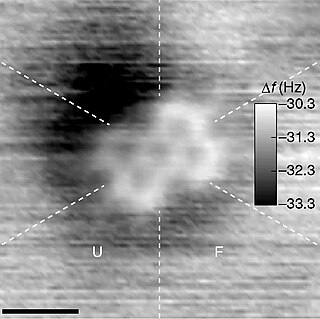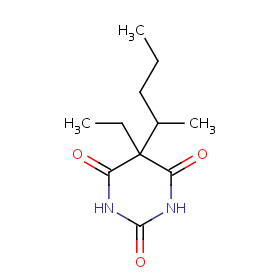The molecular formula C3H3NO3 (molar mass: 101.061 g/mol) may refer to:
- 2,4-Oxazolidinedione
- Glycine N-carboxyanhydride (2,5-Oxazolidinedione)
The molecular formula C3H3NO3 (molar mass: 101.061 g/mol) may refer to:
In chemistry, a chemical formula is a way of presenting information about the chemical proportions of atoms that constitute a particular chemical compound or molecule, using chemical element symbols, numbers, and sometimes also other symbols, such as parentheses, dashes, brackets, commas and plus (+) and minus (−) signs. These are limited to a single typographic line of symbols, which may include subscripts and superscripts. A chemical formula is not a chemical name, and it contains no words. Although a chemical formula may imply certain simple chemical structures, it is not the same as a full chemical structural formula. Chemical formulae can fully specify the structure of only the simplest of molecules and chemical substances, and are generally more limited in power than chemical names and structural formulae.

A molecule is a group of two or more atoms held together by attractive forces known as chemical bonds; depending on context, the term may or may not include ions which satisfy this criterion. In quantum physics, organic chemistry, and biochemistry, the distinction from ions is dropped and molecule is often used when referring to polyatomic ions.
Benzol may refer to:

In science, a formula is a concise way of expressing information symbolically, as in a mathematical formula or a chemical formula. The informal use of the term formula in science refers to the general construct of a relationship between given quantities.

Casomorphin is an opioid peptide derived from the digestion of the milk protein casein.

Oxazolidine is a five-membered ring heterocycle with the formula (CH2)3(NH)O.The O atom and NH groups are not mutually bonded, in contrast to isoxazolidine. Oxazolidines are derivatives of the parent oxazolidine owing to the presence of substituents on carbon and/or nitrogen. Oxazolines are unsaturated analogues of oxazolidines.

2,4-Oxazolidinedione is an organic compound with the formula HN(CO)2OCH2. It is a white solid. The parent ring is not particularly important, but this core structure is found in a variety anticonvulsant drugs. The parent compound is obtained by treating chloroacetamide with bicarbonate.
The molecular formula C6H8O6 (molar mass: 176.124 g/mol) may be:
The molecular formula C6H14 (molar mass: 86.17 g/mol) may refer to:
Dihydroxybenzoic acids (DHBA) are a type of phenolic acids.
Dioxin may refer to:

The molecular formula C11H18N2O3 (molar mass: 226.27 g/mol) may be referred as:
Dihydroxycinnamic acid may refer to several molecules with the molecular formula C9H8O4 including:
Octynes are alkynes with one triple bond and the molecular formula C8H14.
Nonynes are alkynes with one triple bond and the molecular formula C9H16.
Decynes are alkynes with one triple bond and the molecular formula C10H18.
The molecular formula C6H9NO3 (molar mass: 143.142 g/mol) may refer to:
Heptynes are alkynes with one triple bond and the molecular formula C7H12.
Oxazolidinedione may refer to:

Glycine N-carboxyanhydride is an organic compound with the formula HNCH(CO)2O. A colorless solid, it is the product of the phosgenation of glycine. Glycine N-carboxyanhydride is the simplest member of the amino acid N-carboxyanhydrides. It is also the parent of the 2,5-Oxazolidinedione family of heterocycles.